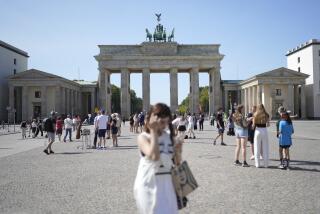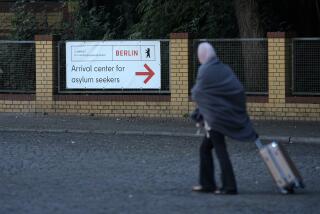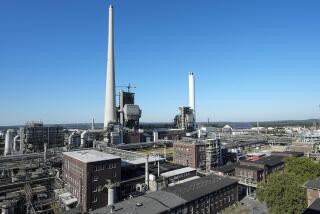Revitalized eastern Germany draws former residents home
- Share via
BERLIN — After a career in tourism that took her around the world, Kristin Ruske finally moved back home to the eastern German city of Wittenberg in 2011. She had left when she was 21, making her way to Switzerland, Los Angeles and then western Germany.
At first she enjoyed traveling the world, but she eventually began thinking about returning to her roots.
“Even though I ended up back in Germany, I was homesick” for the east, said the 33-year-old. “But the opportunities just weren’t there.”
When a job in Wittenberg’s tourism bureau opened up, Ruske jumped at the chance. Even her boyfriend, who had grown up in western Germany, agreed to move with her to the formerly communist east.
“I never heard of someone who would move from West to East before,” Ruske said. “I told him that the new east is the old west.”
Many who left the east in search of job opportunities after German reunification in 1990 are now returning. After years of a westward population drain, experts say reverse migration will soon turn the tide completely.
Former East Germans are being encouraged to return by an improving economy, years of infrastructure investments and better universities. And many residents who might have felt the urge to migrate are staying put.
“Twenty years ago, everything was so nice and pretty in the west. Now Wittenberg is so beautiful,” Ruske said. “There is a flair in the city that was not there before.”
By 2013, the balance of migration will tip, with just as many, if not more, people arriving in the east than departing it, said Thilo Lang of the Leibniz Institute for Regional Geography.
The gap has narrowed considerably over the last decade: In 2010, not including Berlin, 23,577 more people moved to the west than to the east, down from 97,535 in 2001. In major eastern German cities such as Leipzig, Dresden and Potsdam, the balance has already shifted.
Lang estimated that since 1991 about 750,000 “Ossies” — slang for easterners, derived from the German ost, or east — who moved to the western part of the country have returned. Though 1.5 million have remained in the West, a recent survey showed nearly 75% of east Germans living in the west saw themselves returning, up from 50% in 2001.
Life in the former communist East Germany was vastly different for decades. Movies and books were routinely banned; travel was restricted. Easterners got products like Nutella only through care packages. Gray Stalinist buildings were erected and then fell into decay. East Germans drove boxy Trabant cars, which belched exhaust fumes and could reach only 70 mph.
After reunification, many industries in the east lagged far behind those in the west. In July 1992, the unemployment rate stood at 6.5% in the west and 14.6% in the east, said Frank-Juergen Weise, head ofGermany’sFederal Employment Agency.
Many easterners left because they had to, Lang said. Now, although many of the migrants are moving back for emotional rather than economic reasons, they worry less about finding a way to make a living. “People have faith in their region and see a positive future. They have more chances,” Lang said.
Siegfried Buelow, 60, returned to Leipzig in the east because he felt an obligation. “I wanted to build something here,” he said.
He had started his career in a car factory in Chemnitz before reunification and moved to Wolfsburg, in northwestern Germany, in 1991 after his company was sold to Volkswagen through the national reprivatization agency.
“It was emotional, sure,” Buelow recalled. “I had grown up in the east and hadn’t traveled much. My studies, work, everything was confined locally.”
When Buelow moved back to Leipzig in 2000 to head a new Porsche factory, he noticed that things hadn’t changed much.
“But in the last three years, I have seen so many young people who would have moved before now staying,” he said. Even with lower salaries “people just want security, and they can get that here now.”
Many companies in the area are adding jobs, including Porsche, which plans to hire 1,000 people for its Leipzig plant.
Despite recent gains, however, the unemployment rate in eastern Germany remains higher, at 10.3%, compared with 5.9% in the western part of the country.
But because of government subsidies, buildings have been renovated and streets repaved, and there has been growth in manufacturing hubs focusing on sectors such as microchips and automobiles. Even though salaries in the east are on average 17% lower than in the west, the cost of living is also much less.
“From 1998 to about 2005 or 2006, it was a drought,” Kristin Loewe, 32, said of job opportunities near her hometown of Chemnitz, called Karl-Marx-Stadt when she was growing up.
She left for the western town of Bochum in 2000, but by 2009 she was itching to get back. She finally quit her job at a national cellphone operator last year and returned without any job prospects.
In February, four days after she sent in an application, she landed her dream job at a telecommunications company.
“I may earn less money,” she said, but “my grandfathers both died when I was away, and I saw how quickly life goes.”
She is happier being closer to her family, and she sees how things have changed for the better.
“So much money has flowed to the east,” Loewe said. “One can have a cultural life here now that is comparable to what you got in the old German states.”
Rayasam is a special correspondent.
More to Read
Sign up for Essential California
The most important California stories and recommendations in your inbox every morning.
You may occasionally receive promotional content from the Los Angeles Times.










